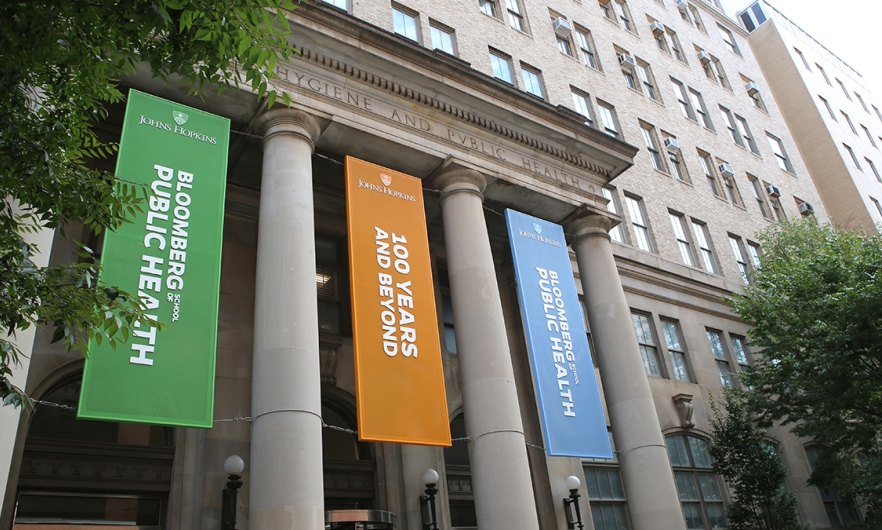One year in, and we’ve only just begun: The Johns Hopkins Center for Gun Violence Solutions celebrates its first anniversary
Reflecting on a year of gun violence prevention efforts with the merged center

Through scientific research that identifies innovative solutions to the gun violence epidemic and advocacy that drives action on the local, state and federal levels, the Johns Hopkins Center for Gun Violence Solutions has made an impact across America in its first year and will continue to drive meaningful change in its second.
Looking Back
Last March, a merger between the former Educational Fund to Stop Gun Violence, a non-profit that advocated for evidence-based solutions to gun violence, and the former Center for Gun Violence Prevention and Policy at the Bloomberg School, established the new Center. The two organizations brought together a growing team of expert researchers and skilled advocates with renewed capacity to impact change.
Shortly after the merger, the Center released an analysis of the 2020 firearm fatality data from the Centers for Disease Control and Prevention, which showed the highest-number of gun deaths ever recorded along with deep underlying demographic disparities. Center researchers also released a study showing an association between removing permit requirements for carrying concealed weapons and a subsequent increase in officer-involved shootings with civilian victims.
Heading into the summer, Center leaders responded to the massacre at an elementary school in Uvalde, TX, calling for the implementation of evidence-based policies to reduce gun violence, including firearm purchaser licensing and Extreme Risk Protection Order laws. When the Supreme Court issued its opinion in NYSRPA v. Bruen, Center experts warned of the impending risk to the safety of millions of Americans.
The Center highlighted progress in the long-standing effort to reduce gun violence by supporting the passage of the Bipartisan Safer Communities Act, which includes, among other things, funding for Extreme Risk Protection Order implementation and community violence intervention initiatives. The Center also released a new survey showing broad support for gun safety measures among the majority of U.S. adults, including support of more than two-thirds of gun owners for requiring individuals to pass a test demonstrating safe and lawful use of firearms before obtaining a concealed carry permit.
The research and advocacy efforts from the Center were instrumental in informing and inspiring the grassroots movement to get Measure 114 on the ballot and passed in Oregon. The new law requires Oregonians to obtain a permit to buy a gun and bans the sale of magazines that hold more than 10 rounds of ammunition, both of which have been shown to reduce gun violence.
The team of dedicated individuals at the Center grew in size and public recognition, as co-director Josh Horwitz, JD, was appointed as the inaugural Dana Feitler Professor of the Practice in Gun Violence Prevention and Advocacy, and Cassandra Crifasi, PhD, MPH, was named as the new co-director of the Center. Horwitz and Shannon Frattaroli, PhD, MPH were the inaugural winners of the Sommer Klag Advocacy Achievement Award for their advocacy impact on Extreme Risk Protection Order laws.
To round out its first year, the Center convened experts for a virtual symposium in February on the deadly connection between white supremacy and firearms, holding crucial conversations about the current state of the crisis and evidence-based policy measures that will have an impact.
Looking Ahead
In our second year, both the Center’s team and its impact will continue to grow as it advances meaningful policies to mitigate the public health crisis of gun violence. A key component of that work will be advocating for progress on the state level, building off the successful ballot initiative to enact gun safety laws in Oregon, an effort fueled by the Center’s research and advocacy. With the Supreme Court’s decision taking further effect, the Center will continue to conduct research on the impact of concealed carry laws and identify actions to make communities safer.
Crucial to our work is the implementation of Extreme Risk Protection Order (ERPO) laws that save lives by temporarily prohibiting access to firearms for those who pose a serious risk to themselves or others. Lisa Geller, MPH, state policy advisor, and Spencer Cantrell, JD, federal affairs advisor, will lead the new Johns Hopkins ERPO Resource Center, which will offer technical and training assistance on ERPO implementation across the country and is supported by a $2 million grant from the Department of Justice.
The Center also contributed to a growing body of evidence on the impact of community violence interruption programs with the release of a study of Baltimore’s Safe Streets program. The report provides an analysis of the program over a period of 15 years, from 2007 to 2022, finding that it reduced homicides and nonfatal shootings overall.
In the Center’s efforts to explore the various factors that contribute to gun violence, this year researchers will complete a study on the impact of alcohol on the gun violence epidemic. Recognizing that widespread public support for effective gun safety measures is key to the Center’s work, in year two it will also shed more light on the attitudes of Americans on gun violence-related policies with the 6th wave of its public opinion polling survey. As the result of a $5 million grant from the Robert Wood Johnson Foundation, the Center will pursue new efforts to expand diversity, equity, and inclusion in the gun violence prevention movement and gun policy research.
As the epidemic of gun violence persists, so must the critical work of the Center. But in its first year, the Center and its supporters have seen moments of optimism that demonstrated the impact of its unique ability to turn public health research into action that reduces deaths and injuries from gun violence. In the new year, that mission continues.
